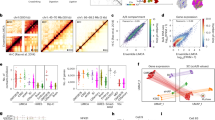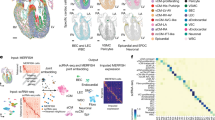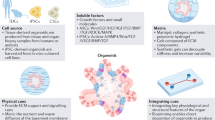Abstract
We describe a protocol for the generation of a functional and transplantable corneal epithelium derived from human induced pluripotent stem (iPS) cells. When this protocol is followed, a proportion of iPS cells spontaneously form circular colonies, each of which is composed of four concentric zones. Cells in these zones have different morphologies and immunostaining characteristics, resembling neuroectoderm, neural crest, ocular-surface ectoderm, or surface ectoderm. We have named this 2D colony a 'SEAM' (self-formed ectodermal autonomous multizone), and previously demonstrated that cells within the SEAM have the potential to give rise to anlages of different ocular lineages, including retinal cells, lens cells, and ocular-surface ectoderm. To investigate the translational potential of the SEAM, cells within it that resemble ocular-surface epithelia can be isolated by pipetting and FACS sorting into a population of corneal epithelial-like progenitor cells. These can be expanded and differentiated to form an epithelial layer expressing K12 and PAX6, and able to recover function in an animal model of corneal epithelial dysfunction after surgical transplantation. The whole protocol, encompassing human iPS cell preparation, autonomous differentiation, purification, and subsequent differentiation, takes between 100 and 120 d, and is of potential use to researchers with an interest in eye development and/or ocular-surface regeneration. Experience with human iPS cell culture and sorting via FACS will be of benefit for researchers performing this protocol.
This is a preview of subscription content, access via your institution
Access options
Access Nature and 54 other Nature Portfolio journals
Get Nature+, our best-value online-access subscription
$29.99 / 30 days
cancel any time
Subscribe to this journal
Receive 12 print issues and online access
$259.00 per year
only $21.58 per issue
Buy this article
- Purchase on Springer Link
- Instant access to full article PDF
Prices may be subject to local taxes which are calculated during checkout





Similar content being viewed by others
References
Ikeda, H. et al. Generation of Rx+/Pax6+ neural retinal precursors from embryonic stem cells. Proc. Natl. Acad. Sci. USA 102, 11331–11336 (2005).
Kawasaki, H. et al. Generation of dopaminergic neurons and pigmented epithelia from primate ES cells by stromal cell-derived inducing activity. Proc. Natl. Acad. Sci. USA 99, 1580–1585 (2002).
Eiraku, M. et al. Self-organizing optic-cup morphogenesis in three-dimensional culture. Nature 472, 51–56 (2011).
Nakano, T. et al. Self-formation of optic cups and storable stratified neural retina from human ESCs. Cell Stem Cell 10, 771–785 (2012).
Zhong, X. et al. Generation of three-dimensional retinal tissue with functional photoreceptors from human iPSCs. Nat. Commun. 5, 4047 (2014).
Reichman, S. et al. From confluent human iPS cells to self-forming neural retina and retinal pigmented epithelium. Proc. Natl. Acad. Sci. USA 111, 8518–8523 (2014).
Mellough, C.B. et al. IGF-1 signaling plays an important role in the formation of three-dimensional laminated neural retina and other ocular structures from human embryonic stem cells. Stem Cells 33, 2416–2430 (2015).
Hayashi, R. et al. Co-ordinated ocular development from human iPS cells and recovery of corneal function. Nature 531, 376–380 (2016).
Hayashi, R. et al. Generation of corneal epithelial cells from induced pluripotent stem cells derived from human dermal fibroblast and corneal limbal epithelium. PLoS One 7, e45435 (2012).
Shalom-Feuerstein, R. et al. Pluripotent stem cell model reveals essential roles for miR-450b-5p and miR-184 in embryonic corneal lineage specification. Stem Cells 30, 898–909 (2012).
Bock, C. et al. Reference maps of human ES and iPS cell variation enable high-throughput characterization of pluripotent cell lines. Cell 144, 439–452 (2011).
Nasu, A. et al. Genetically matched human iPS cells reveal that propensity for cartilage and bone differentiation differs with clones, not cell type of origin. PLoS One 8, e53771 (2013).
Kim, K. et al. Epigenetic memory in induced pluripotent stem cells. Nature 467, 285–290 (2010).
Takahashi, K. et al. Induction of pluripotent stem cells from adult human fibroblasts by defined factors. Cell 131, 861–872 (2007).
Nakagawa, M. et al. A novel efficient feeder-free culture system for the derivation of human induced pluripotent stem cells. Sci. Rep. 4, 3594 (2014).
Kajiwara, M. et al. Donor-dependent variations in hepatic differentiation from human-induced pluripotent stem cells. Proc. Natl. Acad. Sci. USA 109, 12538–12543 (2012).
Miyazaki, T. et al. Laminin E8 fragments support efficient adhesion and expansion of dissociated human pluripotent stem cells. Nat. Commun. 3, 1236 (2012).
Collinson, J.M., Quinn, J.C., Hill, R.E. & West, J.D. The roles of Pax6 in the cornea, retina, and olfactory epithelium of the developing mouse embryo. Dev. Biol. 255, 303–312 (2003).
Ouyang, H. et al. WNT7A and PAX6 define corneal epithelium homeostasis and pathogenesis. Nature 511, 358–361 (2014).
Pang, Z.P. et al. Induction of human neuronal cells by defined transcription factors. Nature 476, 220–223 (2011).
Yang, A. et al. p63 is essential for regenerative proliferation in limb, craniofacial and epithelial development. Nature 398, 714–718 (1999).
Senoo, M., Pinto, F., Crum, C.P. & McKeon, F. p63 is essential for the proliferative potential of stem cells in stratified epithelia. Cell 129, 523–536 (2007).
Meyer, J.S. et al. Modeling early retinal development with human embryonic and induced pluripotent stem cells. Proc. Natl. Acad. Sci. USA 106, 16698–16703 (2009).
Kim, J., Lo, L., Dormand, E. & Anderson, D.J. SOX10 maintains multipotency and inhibits neuronal differentiation of neural crest stem cells. Neuron 38, 17–31 (2003).
Ooto, S. Induction of the differentiation of lentoids from primate embryonic stem cells. Invest. Ophthalmol. Vis. Sci. 44, 2689–2693 (2003).
Cvekl, A., Yang, Y., Chauhan, B.K. & Cveklova, K. Regulation of gene expression by Pax6 in ocular cells: a case of tissue-preferred expression of crystallins in lens. Int. J. Dev. Biol. 48, 829–844 (2004).
Thomson, J.A. et al. Embryonic stem cell lines derived from human blastocysts. Science 282, 1145–1147 (1998).
Stepp, M.A., Spurr-Michaud, S., Tisdale, A., Elwell, J. & Gipson, I.K. Alpha 6 beta 4 integrin heterodimer is a component of hemidesmosomes. Proc. Natl. Acad. Sci. USA 87, 8970–8974 (1990).
Dowling, J., Yu, Q.-C. & Fuchs, E. Beta4 integrin is required for hemidesmosome formation, cell adhesion and cell survival. J. Cell Biol. 134, 559–572 (1996).
Truong, T.T., Huynh, K., Nakatsu, M.N. & Deng, S.X. SSEA4 is a potential negative marker for the enrichment of human corneal epithelial stem/progenitor cells. Invest. Ophthalmol. Vis. Sci. 52, 6315–6320 (2011).
Nishida, K. et al. Corneal reconstruction with tissue-engineered cell sheets composed of autologous oral mucosal epithelium. N. Engl. J. Med. 351, 1187–1196 (2004).
Kawasaki, H. et al. Induction of midbrain dopaminergic neurons from ES cells by stromal cell-derived inducing activity. Neuron 28, 31–40 (2000).
Nishida, K. et al. Functional bioengineered corneal epithelial sheet grafts from corneal stem cells expanded ex vivo on a temperature-responsive cell culture surface. Transplantation 77, 379–385 (2004).
Acknowledgements
We thank Y. Kobayashi for technical assistance. This work was supported in part by the Project for the Realization of Regenerative Medicine of the Japan Agency for Medical Research and Development (AMED) (K.N.), as well as by a Grant-in-Aid for Scientific Research from the Ministry of Education, Culture, Sports, Science and Technology of Japan (R.H.). Corneal research at Cardiff University (A.J.Q.) is supported by the Biotechnology and Biological Sciences Research Council and the Medical Research Council.
Author information
Authors and Affiliations
Contributions
R.H. and K.N. designed the research; R.H., Y.I., R.K., and H.T. performed the experiments on human iPS cell differentiation culture and acquired the data; Y.T. performed the experiments on human iPS cell maintenance in culture and acquired the data; Y.I. and R.K. performed the cell sorting experiments and acquired the data; R.H., Y.I., R.K., Y.T., and H.T. analyzed the data and provided technical assistance to the protocol; Y.S., M.T., and A.J.Q. supervised the project and provided critical advice; K.S. provided reagents (LN511E8); and R.H. and A.J.Q. wrote the manuscript.
Corresponding authors
Ethics declarations
Competing interests
The authors declare no competing financial interests.
Rights and permissions
About this article
Cite this article
Hayashi, R., Ishikawa, Y., Katori, R. et al. Coordinated generation of multiple ocular-like cell lineages and fabrication of functional corneal epithelial cell sheets from human iPS cells. Nat Protoc 12, 683–696 (2017). https://doi.org/10.1038/nprot.2017.007
Published:
Issue Date:
DOI: https://doi.org/10.1038/nprot.2017.007
This article is cited by
-
Single nuclei transcriptomics of the in situ human limbal stem cell niche
Scientific Reports (2024)
-
Current advances in human-induced pluripotent stem cell-based models and therapeutic approaches for congenital heart disease
Molecular and Cellular Biochemistry (2024)
-
Progress of iPS cell-based transplantation therapy for retinal diseases
Japanese Journal of Ophthalmology (2023)
-
Multiplex viral tropism assay in complex cell populations with single-cell resolution
Gene Therapy (2022)
-
Generation of 3D lacrimal gland organoids from human pluripotent stem cells
Nature (2022)
Comments
By submitting a comment you agree to abide by our Terms and Community Guidelines. If you find something abusive or that does not comply with our terms or guidelines please flag it as inappropriate.



